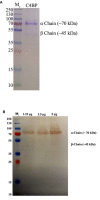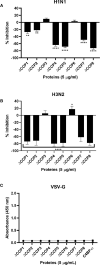C4b Binding Protein Acts as an Innate Immune Effector Against Influenza A Virus
- PMID: 33488586
- PMCID: PMC7820937
- DOI: 10.3389/fimmu.2020.585361
C4b Binding Protein Acts as an Innate Immune Effector Against Influenza A Virus
Abstract
C4b Binding Protein (C4BP) is a major fluid phase inhibitor of the classical and lectin pathways of the complement system. Complement inhibition is achieved by binding to and restricting the role of activated complement component C4b. C4BP functions as a co-factor for factor I in proteolytic inactivation of both soluble and cell surface-bound C4b, thus restricting the formation of the C3-convertase, C4b2a. C4BP also accelerates the natural decay/dissociation of the C3 convertase. This makes C4BP a prime target for exploitation by pathogens to escape complement attack, as seen in Streptococcus pyogenes or Flavivirus. Here, we examined whether C4BP can act on its own in a complement independent manner, against pathogens. C4BP bound H1N1 and H3N2 subtypes of Influenza A Virus (IAV) most likely via multiple sites in Complement Control Protein (CCP) 1-2, 4-5, and 7-8 domains of its α-chain. In addition, C4BP CCP1-2 bound H3N2 better than H1N1. C4BP bound three IAV envelope proteins: Haemagglutinin (~70 kDa), Neuraminidase (~55 kDa), and Matrix protein 1 (~25kDa). C4BP suppressed H1N1 subtype infection into the lung epithelial cell line, A549, while it promoted infection by H3N2 subtype. C4BP restricted viral entry for H1N1 but had the opposite effect on H3N2, as evident from experiments using pseudo-typed viral particles. C4BP downregulated mRNA levels of pro-inflammatory IFN-α, IL-12, and NFκB in the case of H1N1, while it promoted a pro-inflammatory immune response by upregulating IFN- α, TNF-α, RANTES, and IL-6 in the case of H3N2. We conclude that C4BP differentially modulates the efficacy of IAV entry, and hence, replication in a target cell in a strain-dependent manner, and acts as an entry inhibitor for H1N1. Thus, CCP containing complement proteins such as factor H and C4BP may have additional defense roles against IAV that do not rely on the regulation of complement activation.
Keywords: C4BP; complement; inflammation; influenza A virus; pseudo-typed lentiviral particles.
Copyright © 2021 Varghese, Murugaiah, Beirag, Temperton, Khan, Alrokayan, Al-Ahdal, Nal, Al-Mohanna, Sim and Kishore.
Conflict of interest statement
The authors declare that the research was conducted in the absence of any commercial or financial relationships that could be construed as a potential conflict of interest. The reviewer KR declared a shared affiliation with one of the authors, RS, to the handling editor at the time of review.
Figures







Similar articles
-
Human Properdin Released By Infiltrating Neutrophils Can Modulate Influenza A Virus Infection.Front Immunol. 2021 Dec 9;12:747654. doi: 10.3389/fimmu.2021.747654. eCollection 2021. Front Immunol. 2021. PMID: 34956182 Free PMC article.
-
Complement-Independent Modulation of Influenza A Virus Infection by Factor H.Front Immunol. 2020 Mar 25;11:355. doi: 10.3389/fimmu.2020.00355. eCollection 2020. Front Immunol. 2020. PMID: 32269562 Free PMC article.
-
Full-length human surfactant protein A inhibits influenza A virus infection of A549 lung epithelial cells: A recombinant form containing neck and lectin domains promotes infectivity.Immunobiology. 2019 May;224(3):408-418. doi: 10.1016/j.imbio.2019.02.006. Epub 2019 Feb 11. Immunobiology. 2019. PMID: 30954271
-
C4b-binding protein: The good, the bad and the deadly. Novel functions of an old friend.Immunol Lett. 2016 Jan;169:82-92. doi: 10.1016/j.imlet.2015.11.014. Epub 2015 Dec 2. Immunol Lett. 2016. PMID: 26658464 Review.
-
Complement inhibitor C4b-binding protein-friend or foe in the innate immune system?Mol Immunol. 2004 Apr;40(18):1333-46. doi: 10.1016/j.molimm.2003.12.002. Mol Immunol. 2004. PMID: 15072852 Review.
Cited by
-
The complement cascade in lung injury and disease.Respir Res. 2024 Jan 4;25(1):20. doi: 10.1186/s12931-023-02657-2. Respir Res. 2024. PMID: 38178176 Free PMC article. Review.
-
Natural Antioxidant By-Product Mixture Counteracts the Effects of Aflatoxin B1 and Ochratoxin A Exposure of Piglets after Weaning: A Proteomic Survey on Liver Microsomal Fraction.Toxins (Basel). 2023 Apr 19;15(4):299. doi: 10.3390/toxins15040299. Toxins (Basel). 2023. PMID: 37104237 Free PMC article.
-
Diverse Functions of C4b-Binding Protein in Health and Disease.J Immunol. 2023 Nov 15;211(10):1443-1449. doi: 10.4049/jimmunol.2300333. J Immunol. 2023. PMID: 37931209 Free PMC article. Review.
-
Human C1q Regulates Influenza A Virus Infection and Inflammatory Response via Its Globular Domain.Int J Mol Sci. 2022 Mar 11;23(6):3045. doi: 10.3390/ijms23063045. Int J Mol Sci. 2022. PMID: 35328462 Free PMC article.
-
Machine Learning-Based Identification of Potentially Novel Non-Alcoholic Fatty Liver Disease Biomarkers.Biomedicines. 2021 Nov 7;9(11):1636. doi: 10.3390/biomedicines9111636. Biomedicines. 2021. PMID: 34829865 Free PMC article.
References
-
- Okrój M, Blom AM. The complement facts book. London, United Kingdom:Academic Press; (2018). 10.1016/c2015-0-06595-9 - DOI
Publication types
MeSH terms
Substances
LinkOut - more resources
Full Text Sources
Other Literature Sources
Medical
Research Materials
Miscellaneous

